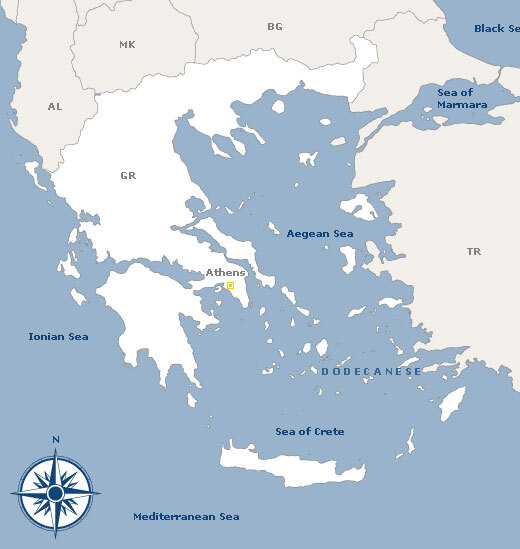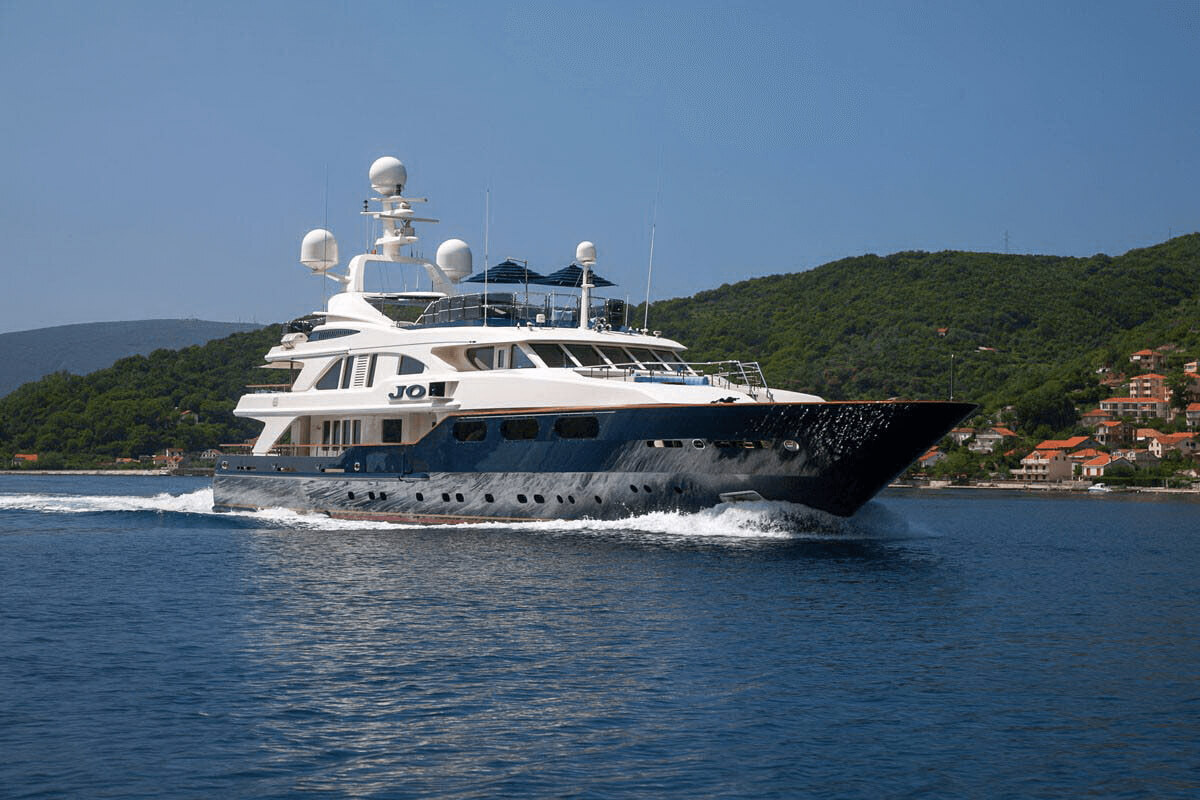About Greece
The Greek coasts
The Greek coast has a total length of approximately 16,000 km. Half of these are on the thousands of Greek islands, while the rest extends along the mainland. What characterises the famous Greek coasts is their unique diversity (beaches stretching over many kilometres, small bays and coves, sandy beaches with dunes, pebbly shores, coastal caves surrounded by steep rocks and with the characteristic dark sand of volcanic soils, coastal wetlands), their clean and transparent waters which have made them renowned all over the world and, for this reason, extremely popular.
In 2005, Greece had 383 beaches and 5 marinas that were awarded the “Blue Flag” (See below), a fact that puts the country in a top-ranking position among the European countries.
Most of the thousands of Greek coasts are freely accessible and you have the opportunity to discover and enjoy them without the presence of a large number of swimmers. There are, however, also many organised beaches in the country with the necessary infrastructure providing high-quality services (umbrellas, reclining chairs, changing booths, cafes, bar-restaurants etc), where, apart from swimming, you can enjoy water sports (water ski, windsurfing, diving etc) as well as other means of having fun in the water, such as the parachute for one or two persons, “tyres” and the “banana”, pedalo, jet ski etc. All organised beaches also have lifeguard towers ensuring safe swimming in the area.

Greek Islands
The islands are Greece’s chief morphological trait and an integral part of the country’s civilisation and tradition. The Greek territory comprises 6,000 islands and islets scattered in the Aegean and Ionian Sea, a truly unique phenomenon on the European continent; of these islands only 227 are inhabited.
The Greek Archipelago takes up 7,500 km of the country’s total 16,000-km coastline, offering a highly diversified landscape: beaches stretching along many kilometers, sheltered bays and coves, golden stretches of sand with dunes, pebbly beaches, coastal caves with steep rocks and black sand typical of volcanic soil, coastal wetlands… Many Greek beaches have been awarded the blue flag under the programme Blue Flags of Europe . Apart from swimming, they lend themselves to scuba diving, snorkeling, water skiing, sailing and windsurfing. As they are the cradle of some of the most ancient and prosperous European civilisations (the Cycladic, Minoan civilisations, etc.), the islands boast unique archaeological sites, an outstanding architectural heritage and centuries-old, fascinating local traditions of a multifaceted cultural past. Moreover, 58.5% of the country’s lodging establishments and 62.6% of hotel beds are found on the islands (data for 2003). All the above, combined with the ideal climate, the safety of Greek waters and the short distances between ports and coasts, have rendered the Greek islands extremely popular among Greek and foreign visitors.
Most islands lie in the Aegean Sea and are divided in seven groups (from north to south):
- The Northeastern Aegean Islands: Agios Efstratios, Thasos, Ikaria, Lesvos, Limnos, Inousses, Samos, Samothrace, Chios, Psara.
- The Sporades: Alonissos, Skiathos, Skopelos, Skyros
- Evia
- The Argo-Saronic Islands: Angistri, Aegina, Poros, Salamina, Spetses, Hydra and the coastal area of Methana.
- The Cyclades: A group of 56 islands, its most important ones being Amorgos, Anafi, Andros, Antiparos, Delos, Ios, Kea, Kimolos, Kythnos, Milos, Mykonos, Naxos, Paros, Santorini, Serifos, Sikinos, Sifnos, Syros, Tinos, Folegandros, as well as the “Minor Cyclades” comprising Donousa, Irakleia, Koufonisia and Schinoussa.
- The Dodecanese: Astypalaia, Kalymnos, Karpathos, Thasos, Kastelorizo, Kos, Lipsi, Leros, Nisyros, Patmos, Rhodes, Symi, Tilos, Halki.
- Crete
- The Ionian Sea is home to one sole island group:
- The Ionian Islands: Zakynthos, Ithaca, Corfu, Cephallonia, Lefkada, Paxi, Antipaxi, Ereikoussa, Mathraki, Meganissi, Othoni, Strofades.
These islands, together with Kythira, which is however cut-off from the rest, opposite the southern Peloponnese (Lakonia), as well as neighbouring Antikythira, they constitute the Eptanissa.
Winds in Greece
Aegean Sea
The Aegean Sea winds usually appear during the warm season, i.e. from May to September, blow in a northward direction and are called etisies or meltemia. Normally, the meltemia season begins around the end of May and ends around the end of October. They are the strongest during the months of July and August, and their average duration is from 2 to 4 days, although they do not have the same frequency of appearance every year. These winds mostly blow during the day, from 8 in the morning to 8 in the evening, and are at their strongest around 2 in the afternoon.
They are characterised by alternate strengthening and weakening, while they fall quickly after sundown, to return at dawn. In the Northern Aegean they usually are NE winds, in the Central Aegean they become North, and in the Southern Aegean NW. In the area of Rhodos they tend to become West, while in the Saronikos and the Northern Evoikos Gulf they remain NE. Under the influence of the sea breeze during the day, the meltemia become stronger locally, as is the case in the coastal area of Northern Crete. The meltemia are at their most intense in the N. Aegean, particularly in the region of the Cyclades islands.
During the winter, the winds blowing in the Aegean reach a force of 8-9 Beaufort, while greater intensity is observed in the Kafireas straits (Cavo Doro) and in the Cyclades.
With regard to the waters in the Thermaikos Gulf, there we encounter the strong local NW wind called vardaris, with strengths that range from 6 to 8 Beaufort. Also during the winter, and particularly when it is at its coldest, a humid wind in the Aegean region, which becomes gradually stronger , accompanied by low skies and rain. It appears mostly in the southern and western regions of the Aegean, but this stormy wind does not make an appearance often.
Ionian Sea
The winds blowing in the Ionian Sea during the summer are the NW “maϊstros” winds, while during the winter we also have the wet sirocco, that, when at its strongest, can blow for 2 or 3 days without stop. Also during the winter, and to a lesser extent in the summer, blows the NE Central Mediterranean wind called “gregos”, which comes from Albania and Western Greece. It creates strong waves in the winter, but does not blow in the summer.
Wind Zones
Zones
It is useful to divide the Greek seas into 4 zones running from North to South, and thus examine the course of the summer winds.
Winds vary greatly from zone to zone, (except when the meltemia winds are blowing, which are very strong, and result in large areas overlapping and having the same features).
More specifically:
THE FIRST ZONE includes the Ionian Sea and the West Coasts of the Peloponnese. For the greater part of the summer, the North Ionian features light to medium NW winds, the maïstros, which appear in the early afternoon and usually fall during sundown.
The SECOND ZONE is the sea area that is located south of Attiki and east of the Peloponnese. Very often in this area we have the southerly (SE) sirocco wind, the duration of which is usually short. The sea in the north part of this zone is protected from the strong northern winds by the land areas. In early summer there often is no wind at all, or weak winds blow, generally from the south. However, from July till the end of the summer, in this zone we mostly have meltemia, except for the NW Peloponnese, where you may have encounter western winds.
THE THIRD AND CENTRAL ZONE covers the greater part of the Aegean from North to South, including the Sporades and the Cyclades. Throughout the summer, the prevailing winds are northeastern winds in the Northern Aegean, and northwestern winds in the Southern Aegean. The meltemia are weaker during May and June, stronger during July and August, but disappear in the fall, when the high Balkan barometric pressures are decrease. These are not cold winds, but they may blow continuously for 3 to 4 days in a sunny sky, reaching an intensity of force 6 and in some cases 7 to 8 on the Beaufort scale. They create sudden waves that may make conditions difficult for small pleasure craft, particularly in the sea areas around the island of Icaria and the Cavo Doro, north of Andros.
THE FOURTH ZONE, comprises the sea areas of the NE Aegean, as well as the sea of Samos and Kos before the coast of Turkey, is considerably influenced by the meltemia, particularly in the north. However, during the greater part of the summer a slight, variable breeze blows on the coasts of the southern region.
In order to obtain more information regarding the winds and the navigation weather forecasts, please follow the weather forecast broadcasts.




